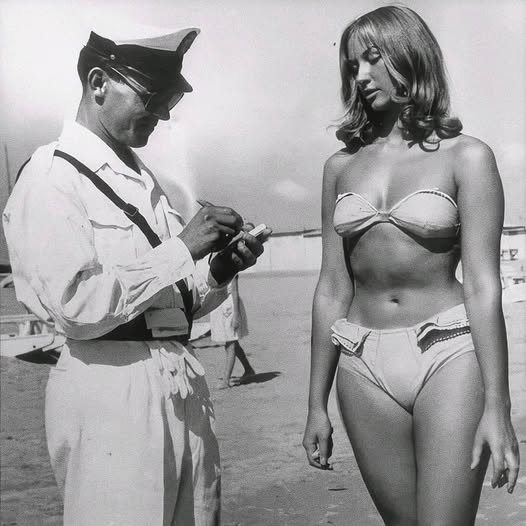At first glance, it might seem like just a simple photo of a woman enjoying a sunny day at the beach, but a closer look reveals a much deeper story—a story woven into the fabric of the garment she’s wearing. That tiny piece of clothing, the bikini, has carried far more weight than its small size might suggest. It has sparked outrage, provoked bans, stirred debates, and even led to arrests across the globe

Throughout history, in the ongoing tug-of-war between modesty and freedom, the bikini has emerged as both a controversial figure and a powerful symbol of liberation. Once condemned by religious authorities like the Pope and outlawed by multiple governments, it has been consistently embraced by generations of women determined to assert their right to self-expression. To understand how a simple swimsuit became such a cultural flashpoint, you have to look back to the early 20th century. At that time, swimwear was anything but daring—full-body, woolen suits were the norm, covering from neck to knee and designed to meet strict standards of public decency. In places like Chicago’s Clarendon Beach, officials even had tailors on standby to add fabric to suits deemed too revealing. In New York’s Coney Island, “bathing socks” were banned in 1915 if they revealed too much of a woman’s knees.
In Washington, D.C., beach patrols measured swimsuit lengths with tape to enforce modesty regulations. During this era, exposing arms or legs was enough to draw scandal. But tides were beginning to turn. In 1907, Australian swimmer Annette Kellerman dared to wear a form-fitting one-piece suit that exposed her arms, legs, and neck—ditching the bulky pantaloons of her time. Though there are conflicting records about whether she was actually arrested, her boldness made headlines and sparked a revolution in women’s swimwear. Her “Annette Kellermans” swimwear line became wildly popular and helped pave the way for more practical, stylish options. In the 1920s, social norms began shifting even further, and a group of rebellious California women known as the “skirts be hanged girls” began advocating for less restrictive, body-hugging swimsuits that allowed for easier movement.
Although swimsuits remained relatively modest by today’s standards, the push for liberation was undeniable. Then came the game-changer: in 1946, French engineer Louis Réard unveiled the bikini, a two-piece design that exposed the navel and more skin than had ever been shown in public swimwear. The launch happened just days after nuclear testing at Bikini Atoll, a move some believe was a deliberate marketing strategy to emphasize the swimsuit’s explosive impact. Reaction to the bikini was swift and fierce. It was banned on beaches in the U.S., France, and Germany. Communist leaders denounced it as morally corrupt.
Pope Pius XII called it sinful. Countries like Belgium, Italy, Portugal, and Spain outlawed it entirely. In Australia, model Ann Ferguson was asked to leave a beach in 1952 because her bikini was deemed indecent. A now-iconic photo of a uniformed officer confronting a woman in a bikini on an Italian beach summed up the moment—even if the full story behind the image remains unclear, the tension between tradition and change was undeniable. It wasn’t until the 1960s that the bikini began to gain more mainstream acceptance. The rise of feminism, changes in pop culture, and a loosening of censorship in Hollywood helped open the door. Still, barriers remained—Hollywood’s Hays Code forbade showing bellybuttons on screen, and the National Legion of Decency worked to keep bikinis out of movies. But stars like Marilyn Monroe, Brigitte Bardot, and Ursula Andress began rewriting the rules. Bardot brought the bikini to life on film, turning it into a fashion statement, while Andress’s famous beach scene in Dr. No redefined the swimsuit as a symbol of empowerment. By the 1970s, the bikini was no longer a symbol of rebellion—it had become part of mainstream fashion. Styles grew bolder, and both women’s and men’s swimwear leaned into minimalism. Today, swimwear represents personal choice more than any social code. Whether it’s a full-coverage one-piece or a daring string bikini, the conversation is no longer about what’s appropriate, but what feels right for the person wearing it. Swimwear has become an expression of identity, confidence, and freedom. That simple photo of a woman on the beach? It’s not just a snapshot of summer—it’s a reminder of how far we’ve come in embracing individuality, personal freedom, and the right to be seen exactly as we are.





